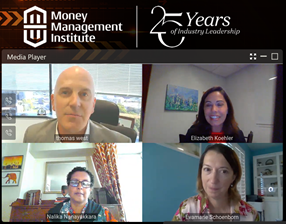Financial Wellness: For Advisors and Clients
by Thomas C. West, Senior Advisor at Signature Estate & Investment Advisors, and creator of the Lifecare Affordability Plan, a durable health-driven financial planning process
What is the definition of financial wellness?

The definition of financial wellness is still in flux. We, as an industry, are still trying to define not just what it is, but also the best way to integrate it into a variety of different business models. We were sensitive to the range of understanding of what financial wellness means so we can make some progress together.
Why does your practice focus on how to serve aging clients, including how to help clients prepare for where they’re going to live as they get older? Why is this important and how do you embed this work into your practice at SEIA?
One of the things that we try to specialize in our practice is creating distinct analyses about changes in housing and healthcare for our aging clients. It’s an area where we are trying to differentiate some of our offers. I think it’s smart business. It’s an opportunity to attract attention, to differentiate in the market in a space that financial advisors tend not to specialize in.
The second reason has a little bit to do with my philosophy. We, as an industry, historically have done a pretty good job of giving counsel in the accumulation phase, but we are just now starting to get a handle on counseling in the decumulation phase. If we think about the chapter in a client’s life where there might be changes based on housing, a lot of times this is driven by priorities around health security or lifestyle preferences. But as it relates to the real client experience, this can be something that has particularly volatile or unpredictable cash flow needs. That’s an area that I believe the industry has ground to make up in terms of the value proposition for aging clients.
The third reason that I specialize in the financial wellness space is a combination of what clients want and what clients need. Changes in housing, for example, might be the last significant financial decision that our clients might be making, and having some specialization in this area has treated our practice well.
To wrap up, I focus a lot on the outcomes that my clients are most hopeful for. Depending on where they are in a particular chapter of their life, getting a shared understanding of outcomes that they are hopeful for tends to drive calls to action and recommendations. People are a bit more responsive to acting on what they are most hopeful for.
What is involved in financial wellness conversations with clients?

We need to embed financial wellness into our conversations with clients regularly. It usually involves three different factors:
- Make sure that we’re going to where the client is, even if, as an advisor, we can see 5 or 10 steps ahead.
- Make sure that we collectively understand that change happens and that change happens sometimes at a time of our choosing or at a time, not of our choosing.
- Make sure with my responsibility as a financial advisor to help support durable decision-making, because we know changes are coming.
Why hasn’t the concept of financial wellness taken hold widely yet?
My sense is that firms and advisors feel like they don’t have the right tools, either with technology or soft skills.
Advisors were historically trained to recommend and then pull or push somebody toward the desired future outcome and to steward better choices. The root of the backgrounds of many successful financial advisors is usually analytical or quantitative, or it’s sales oriented. For me, I’m coming from the sales side of things. My training involved being able to profile my client by understanding the emotional triggers and analytical due diligence that it will take to guide somebody to a recommendation and, finally, to a call to action.
Today, I think a lot of clients want somebody to be experiencing with them shoulder-to-shoulder during their different life chapters. The idea that I have a fellow traveler as I’m walking through all my different life paths is comforting. But we, as advisors, haven’t really been trained to do that. If we think of the soft sciences, like active listening or being emotionally present, this has nothing to do with my training when I was coming up on the sales side. My training was more along the lines of what do I need to profile somebody to develop the sequence of recommendations that can move somebody to a call to action. Advisors with similar training to me may feel held back when having financial wellness conversations with clients.
Our industry needs to widen its scope. We need to move toward being more holistic, and a little bit more present with the client, as compared to only coming up with recommendations where we are pushing or pulling clients toward a desired better outcome. We need to weigh the typical conversations that clients and advisors have, from slightly more analytical with portfolio returns and risks, to those that are a bit more personal to the client about peace of mind, work-life balance, and mental health.
How do you think about weighing analytical vs. personal topics in your conversations with clients today?
I often use the metaphor about the dog wagging the tail or the tail wagging the dog when we’re talking about different levels of attention that we have with portfolio metrics. Too often, financial advisors focused on performance metrics and what the portfolio is supposed to be doing is the tail that is wagging the dog – meaning what is happening in the portfolio is constraining or driving a set of available choices. I think a lot of times, that is backward. I think that if we start with outcomes that a client might be most helpful for, then we can move them to the place of those outcomes. This process is going to require a discrete set of choices that we’re going to make together, and that leads to a portfolio, for example, that might be organized in a particular way for income, for risk, or for return. We then use the portfolio metrics as one of several different metrics to track progress toward the outcome that clients are most hopeful for.
Additionally, if we bookend our client conversations, given where they are right now, accounting for the changes since the last time we addressed them, with what are the outcomes our clients are most hopeful for, that gets us a little bit closer to sharing an experience with clients where they’re feeling like they have somebody walking shoulder-to-shoulder with them.
What things that we should be thinking about and we should be doing for financial wellness with our clients? Is there anything that perhaps we should stop doing?
People often think they are great listeners. I acknowledge that I’m not a great listener. I’ve got 20 years of experience with clients who are experiencing their own unique life stories. As a professional, I haven’t always seen everybody as a unique grain of sand. My experience has taught me to see them in different buckets with different outcomes and different profiles. It’s a default setting that I’m constantly trying to correct, of not jumping to the end or jumping to the recommendation.
Remember what I said earlier, there’s a value that is underappreciated by advisors — clients want their advisors to be where they are, they don’t want the advisor relationships always to be 5, 10, or 15 steps ahead because they might not be in the position to be able to see that far, even though that might be the advisor’s experience in terms of counseling so many families. Being present and stopping talking is honestly what I tell myself regularly in different client meetings. That’s my two cents. More active listening and stop talking.
Summary
When working with aging clients, financial wellness is smart business. It’s important to meet clients where they need and want advice and consultation the most as they age, including changes in housing and healthcare. Clients want an advisor as a fellow traveler, who is there shoulder-to-shoulder through the different chapters of their lives. Preparing and offering more distinct financial wellness analyses can be a great way to both attract and retain clients in ways that they really need it.
For the industry, being knowledgeable about decumulation is becoming increasingly critical for all of us to be thinking about. I wish a lot more conversations started with “What are the outcomes you are most hopeful for?” Hopeful outcomes are an incredibly important piece for advisors to be thinking about and a direction to be going. It also reminds me of that Forbes article that states empathy is the single most important leadership quality. Our clients truly value the human aspects of our role.
Hopeful outcomes are one way to frame financial wellness conversations with clients because it leads to the discrete choices we’re going to make, and that leads to the portfolio. This serves as a great path for client conversations. Specifically, advisors need to be where clients are, be more present, not jump to the end recommendation, and stop talking so active listening can take place.
